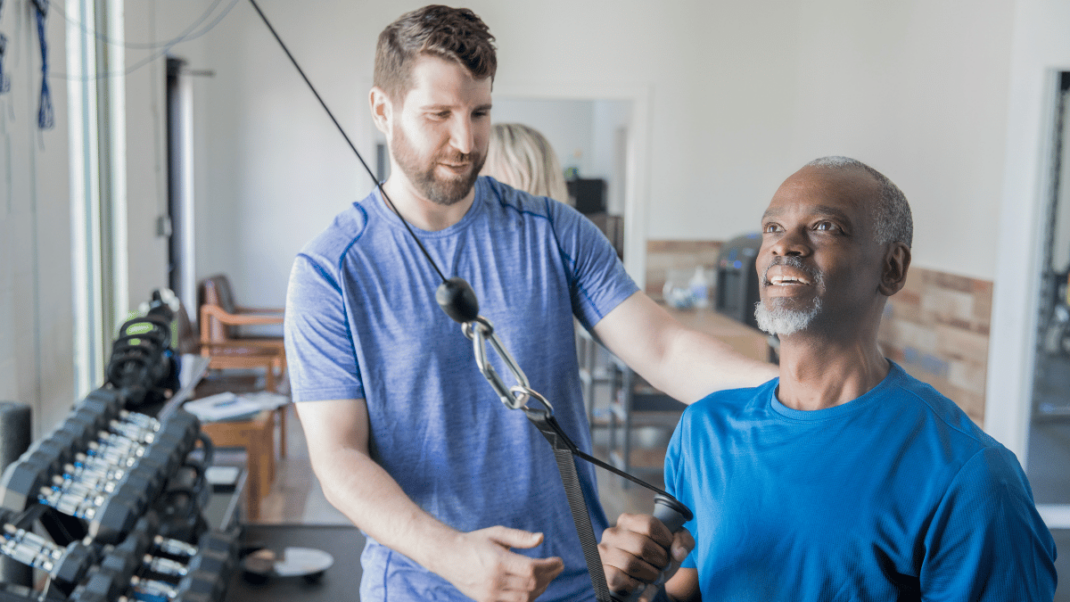Staying in the Fitness Game
Certification is just your ticket in—continuing education is the secret to keeping your career on a winning track.

How do you succeed in the fitness profession? Whether you’ve just gotten certified, you’re returning to a fitness career or you’re an experienced pro who wants to develop new skills, the answer is the same: keep learning. Continuing education is a career necessity that becomes increasingly important as the fitness industry grows more sophisticated, diverse, specialized and evidence-based.
“Lifelong learning is so important in all areas of life, and especially in health and fitness, where information and research are constantly changing,” says Kathie Davis, co-founder of IDEA Health & Fitness Association (IDEA), the world’s largest association for fitness and wellness professionals. “One of the reasons that ongoing education has become a standard in our industry is that the major certifying bodies require it. That makes certification just the first step and encourages people to stay up-to-date. It’s a very positive thing for our industry.”
Going Beyond Certification
The American Council on Exercise® (ACE) has been certifying fitness professionals for more than 25 years. ACE offers its own continuing education courses in addition to approving courses from over 300 continuing education providers in the industry.
“We’ve learned that the credential is a starting point, and then the journey begins,” says Scott Goudeseune, ACE president and chief executive officer. “Our goal is to show fitness pros a career path that will give them the experiences they want and need to be successful and effective. Continuing education [offers] the newest, most relevant, most up-to-date information. It takes you to the next level. For example, you learn the fundamentals of anatomy for your certification, but continuing education can teach you how to apply what you’ve learned to create a great exercise program for the specific needs of your client.”
“Certification ensures that you’ve achieved a minimum level of competence and a foundational level of knowledge to work with apparently healthy adult clients. That’s the beginning step, and everyone needs that, but it’s only the beginning,” says Brian Sutton, content development coordinator for the National Academy of Sports Medicine® (NASM).
One of the industry organizations that focus on research-based education, NASM offers several Web-based degrees and on-campus certification programs through colleges and universities. “We have our own research institute. Every course we offer has gone through the peer-review process,” Sutton says. “It’s important that fitness pros know the education they’re getting is scientifically based, not just hype or a fad or a guru stating his personal opinion.”
Fitness-related education and research at the university level have also increased, says Joe Moore, president and CEO of the International Health, Racquet & Sportsclub Association (IHRSA), the fitness industry trade association that represents more than 9,750 for-profit health and fitness facilities and over 740 supplier companies in 78 countries. “More colleges and universities are offering courses in exercise science, and there’s more research being done today on exercise science and related health areas than ever before. The fitness consumer is also more educated than ever, so the fitness professional has to keep up—not just with the exercise and nutrition aspects, but with the business aspects as well.”
Linda Pfeffer, president of the Aerobics and Fitness Association of America® (AFAA), which has issued over 250,000 certifications, echoes the need to stay current: “As demographics and exercise options change over time, fitness professionals rely on continuing education to understand and address the new challenges brought by these changes.”
More Education Options Than Ever
Most major certifying agencies require approximately 20 hours of approved continuing education credits (CECs) every 2 years in order to renew and maintain their certifications; some require more. Fitness professionals can obtain continuing education courses from numerous industry associations, in many different ways.
As the world’s leading membership organization of health and fitness professionals, with more than 136,000 members and subscribers in over 80 countries, IDEA has been at the forefront of continuing education. Since 1982, the association has provided unbiased data, educational resources and career development opportunities for personal trainers, program and fitness directors, business owners and managers, and group fitness instructors.
“A lot has changed in the last 25 years,” says Davis. “There are many more continuing education opportunities today for fitness professionals. There are more certifying organizations and continuing education providers. What’s probably changed the most is how continuing education is delivered. For example, over the last year we’ve tripled the number of CEC courses available on our website.”
Online Courses and Certificate Programs. IDEA offers over 135 online courses and 120 complete certificate programs, with instant access to course content and tests, immediate results, and transcripts for future reference. In 2009, IDEA also launched streaming event video packages with CECs, filmed live at IDEA fitness events. Each package includes access to streaming videos of the filmed sessions, plus all the CECs needed to maintain certification.
“You can study and take the test online, then send the test directly to your certification organization,” says Davis. “If your schedule or budget doesn’t allow you to attend a conference, you can still get the education.” IDEA provides four conferences every year and offers 23–25 CECs with each fitness event.
Live Chat and Interactive Video. At The Cooper Institute™ in Dallas, the wide variety of continuing education courses includes online courses that offer live chat or live video interaction, as well as At-Your-Site courses. “At one time, you had to come to us,” said Michael Harper, associate director of education at the institute, which has been educating fitness and health leaders worldwide for more than 35 years. “Now we can come to your site. And of course you have that option of taking some online courses without leaving home, in your pajamas. The main thing is to keep learning. The fitness field is relatively young and continuously evolving, with a future that still has some uncharted waters. We learn new things from research all the time. There are a lot of things out on the market, but not everything is safe and effective. Continuing education is the only way to keep growing along with the industry.”
Web Conferencing. With rising demand for Internet-based distance learning, AFAA has developed a new, proprietary interactive video Web-conferencing system, Multitraining Live®, which allows participants to connect, live, with an AFAA instructor. AFAA is enhancing many of its continuing education programs with Multitraining Live group study support sessions.
Publications. Fitness pros can also get more CECs today through industry publications. IDEA Fitness Journal has expanded its CEC opportunities to offer between 0.1 and 0.5 potential credits in every issue. The efficient à la carte system provides more flexibility for fitness pros; they can fit reading and test-taking into approximately 1-hour segments.
Webinars. The American College of Sports Medicine® (ACSM), which focuses on exercise science research, now provides more online continuing education for both fitness professionals and physicians. “We’re much more technologically based than ever more, and we’re rolling out more in the future,” says Richard Cotton, ACSM’s national director of certification and registry. “ACSM establishes many of the guidelines and standards in exercise science, and now we have more opportunities for people to access our education—through online webinars, for example.”
Live Events. Despite the explosion of online learning, the popularity of earning CECs at industry fitness events is still high—perhaps higher than ever. “It’s the difference between going to the Super Bowl and watching it on TV,” says Davis. “There’s a unique kind of excitement and energy that you get only from the live, in-person experience of IDEA fitness events, where you can meet the leading experts in the industry and network with other fitness pros.”
Mark Roozen, MEd, director of certification for the National Strength and Conditioning Association™ (NSCA), which serves nearly 30,000 members in 52 countries, says that online courses supplement, rather than replace, the in-person experience. “We’re seeing a lot more applications for online courses, but people still want to do conferences and clinics, too. People know the value of that hands-on experience. Our attendance numbers are higher than ever for our national conference.”
Goudeseune estimates that only about 7%–10% of fitness professionals currently obtain CECs online. “Online learning hasn’t changed things as much as people may think, but it has helped us communicate and educate in a new way. People still overwhelmingly love to get hands-on experience when they can.”
Cotton notes that the new options have made fitness professionals more careful consumers. “Fitness professionals are more savvy in their education purchases today. They’re not as likely to travel unless they can get something new.”
A New Era of Collaboration. Goudeseune adds that there is more collaboration in fitness education today, as organizations partner to create a wide variety of learning options and to ensure that courses meet high standards. Accreditation of certifying bodies is a relatively new tool that fitness pros can now use to evaluate education options. The National Commission for Certifying Agencies (NCCA) and the Distance Education and Training Council (DETC) are two of the more common accreditations for fitness certification organizations. “Accreditation has helped the industry immensely and removed many of the unqualified education providers in the industry,” says Sutton.
The National Board of Fitness Examiners (NBFE), founded in 2003 to promote standardization in the fitness industry, has created a set of standardized National Board Exams as another certification and continuing education option for fitness pros. “In general, we believe that creating standards within the industry is a good thing,” says NBFE President Sal Arria. “The next step for the fitness community is unity, bringing professionals and organizations together to work toward what’s best for our industry and for the people we help.”
More Market Value
Increasing specialization in the industry is driving the growth of continuing education. “Our diversity gives us strength,” says Moore. “Many fitness consumers are looking for niche programming. Continuing education in a specialty area helps professionals connect with clients.”
NASM offers two advanced specialization course tracks: Performance Enhancement Specialist and Corrective Exercise Specialist. “Our primary audience is personal trainers, but chiropractors, physical therapists and other allied healthcare professionals also take our courses,” says Sutton. “Many people take both programs, and [taking those steps] can increase their client base.”
Says Goudeseune, “We try to provide continuing education that will expose pros to new experiences beyond the four walls of traditional fitness, so they can go into a corporate environment or an older-adult setting, for example, and expand into new markets.” Industry business owners are on board when it comes to the value of education. “Employers look at continuing education as an advantage in the marketplace,” says Moore. “The larger the knowledge base of the staff, the better they will interact with the membership and the better the clubs will do. This is a relationship business, and the club can be the filter for members to sort through the misinformation about health and fitness.”
“Staying up with teacher training is vital to pros who want to advance,” notes Roozen. “When I hired staff, I didn’t just look at job candidates’ certification, but at how they stayed current. If you have a certification that doesn’t require continuing education, it sends up a red flag.”
Continuing Education Planning
How do you choose the best continuing education for your purposes?
Select Your Specialties and Find a Reputable Provider. “Ask yourself what area or areas you want to specialize in, and what clients you want to work with,” suggests Davis. “Once you have some ideas in mind, research your options. Comparison-shop. Get the most value you can. There are lots of opportunities, so take your time and find what best matches your needs. Just check that the course work is being offered by a professional provider with a good reputation in the industry. Make sure it has been approved by your certifying organization before you make your decision. Sometimes you can petition your organization to approve a course—most certifying agencies have a petition process in place.”
Budget for CECs You Need—Plus Some Extra. Goudeseune notes that credits typically cost between $15 and $25 per credit hour. “It can be very affordable. You can often get much of what you need to recertify in a weekend.”
However, he urges fitness pros to get as much education as they possibly can. “Even if the certification process requires only 20 CECs, people who excel in this industry go far beyond that. It’s not about squeezing in just what you need to—it’s the more, the better for your career and for your clients.”
Begin Planning Your Career Development Today. It’s never too early to start planning for continuing education. “The day pros pass their exam, we urge them to map out their career and start the process. The next couple of years will pass quickly, and we want people to make the choices that are best for them, rather than getting whatever is available at the last minute,” says Goudeseune.
Industry experts agree that continuing education is one of the most important components of career planning. “There’s so much information coming out every day for consumers, and they want fitness professionals to make sense of it. You can get lost in the market if you’re not staying up-to-date,” says Roozen. “Consumers are also looking for you to have expertise in fitness specialties that they hear and read about, whether it’s Pilates or functional training or kettlebells, so continuing education in specialty areas is critical from a business standpoint.”
If you plan carefully and have the will to grow, ongoing education can expand your career horizons exponentially. “Continuing education can take you down many paths,” says Sutton. It’s exciting, because you never really know where it’s going to lead.”
- ACSM, www.acsm.org
- ACE, www.acefitness.org
- AFAA, www.afaa.com
- The Cooper Institute, www.cooperinstitute.org
- IDEA, www.ideafit.com
- IHRSA, www.ihrsa.org
- NASM, www.nasm.org
- NBFE, www.nbfe.org
- NSCA, www.nsca-cc.org





